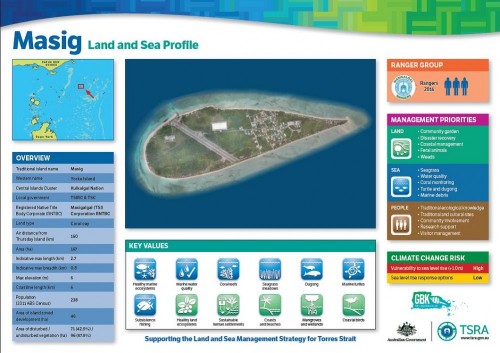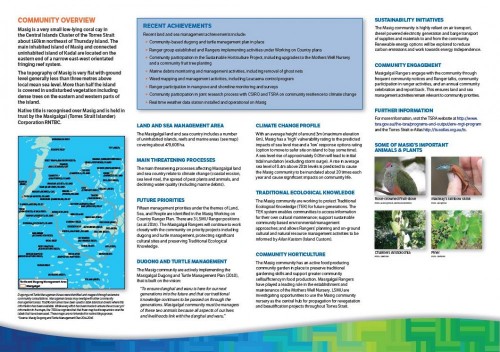About the Land and Sea Management Strategy for the Torres Strait
- What is the Land and Sea Management Strategy for Torres Strait?
- What does the Strategy aim to do?
- What are the guiding principles for land and sea management in the Torres Strait?
- How was the Strategy prepared?
- What are the key natural assets and values of the Torres Strait?
- What is the current state of the environment in Torres Strait?
- Island land and sea profiles
- How will the Strategy be implemented?
- Where can I find out more?
What is the Land and Sea Management Strategy for Torres Strait?
The Land and Sea Management Strategy for Torres Strait (2016-2036) (‘the Strategy’) is a guiding framework for enabling Torres Strait Islander and Aboriginal people to continue to sustainably manage and benefit from their land, sea and cultural resources into the future.
Land and sea management has been central to Torres Strait culture for thousands of years and will continue to be an important part of the future for Indigenous peoples of the region. This new Strategy builds on the many achievements of the original 2005 Strategy and provides the framework for community-based management of the region’s natural and cultural resources over the next 20 years.
What does the Strategy aim to do?
The Land and Sea Management Strategy for Torres Strait (2016-2036) aims to achieve the following vision.
Empowering Torres Strait Islander and Aboriginal peoples to sustainably manage and benefit from their land, sea and cultural resources into the future, in accordance with Ailan Kastom, Aboriginal Lore/Law and native title rights and interests.
The Strategy’s basic aim is to help the Torres Strait communities work together to keep the Torres Strait special by protecting key values (People, Sea, Land) for the future.
To achieve this, the Strategy:
- promotes regional and local land and sea management aspirations and capacity
- helps us to understand the health of key values in the region and how things might be changing
- provides information to support local planning and management efforts
- seeks ongoing investment to enable communities to look after their islands and seas in a culturally appropriate way.
What are the guiding principles for land and sea management in the Torres Strait?
To help achieve the vision, land and sea management in the Torres Strait must:
-
Be culturally appropriate (reinforcing native title rights and interests, respecting Ailan Kastom and Aboriginal Law/Lore, incorporating Traditional Ecological Knowledge, and aligning with Traditional Owner interests);
-
Empower Traditional Owners (supporting self-determination at the local and regional scale);
-
Deliver enduring outcomes (providing environmentally, economically and socially sustainable solutions)
-
Adopt integrated decision making (using evidence-based approaches that take a long-term holistic perspective and consider all relevant factors)
-
Demonstrate strong adaptive management (applying flexible approaches that incorporate learning from experience)
-
Focus on protecting and managing key values (keeping the unique features of Torres Strait secure for the benefit of future generations)
How was the Strategy prepared?
The Land and Sea Management Strategy for Torres Strait was developed in 2005 under the direction of a community-based reference group. To implement the Strategy, the Land and Sea Management Unit (LSMU) was established within the Torres Strait Regional Authority (TSRA) and has been operating since 2006 as the regional natural resource management body for Torres Strait. Over the past 10 years, the Strategy (through the LSMU) has underpinned the successful delivery of the TSRA’s Environmental Management Programme. The Strategy was updated in 2015 to reflect current environmental priorities, conditions and trends, management arrangements, research outcomes, community aspirations and concerns.
Building on the original Land and Sea Management Strategy for Torres Strait (2005), the revised Strategy uses western science, management experience and advice from Traditional Owners to describe the region’s natural and cultural values and priorities for future action. It also seeks to recognise and affirm Torres Strait Islander and Aboriginal peoples’ holistic relationship with their islands and sea country and to empower Traditional Owners to play a lead role in the future sustainable management of the unique environmental and cultural values of our region, in collaboration with other partners. The revised Strategy also seeks to secure ongoing investment for the highly successful Ranger Program and other Indigenous community-based management initiatives.
What are the key natural assets and values of the Torres Strait?
Sixteen key values that make Torres Strait unique have been identified under the themes of People, Sea and Land. For each of these key values, the Strategy identifies the desired outcomes, current situation and strategic management directions.

Ailan Kastom, Aboriginal Lore/Law, culture, traditional ecological knowledge, and native title rights and interests galvanise all aspects of the key People, Sea and Land values of the Torres Strait
What is the current state of the environment in Torres Strait?
Whilst the region’s environment is still largely in healthy condition (11 of the 16 key values are considered to be in good or very good condition), a high level of management and protection is required to maintain and enhance the resilience of these key values in the face of significant challenges driven largely by climate change, economic and social development and population changes across the wider region (including with neighbouring Papua New Guinea).
Best available traditional and scientific knowledge, professional insight and stakeholder perspectives have been used to prepare brief land and sea profiles for each of the 17 inhabited islands and the first ever regional state of environment report card for Torres Strait. The report card provides a succinct yet transparent account of the significance, condition and trend of key regional values and with refinement will provide an improving picture of trends over time to guide ongoing management.
Island land and sea profiles have been prepared for each of the 17 inhabited islands. These profiles are intended to provide key information to support local planning and decision-making in relation to environmental management, and can also be used as educational and promotional tools. They can be reviewed and updated every 3-5 years.


How will the Strategy be implemented?
Strong foundations have been laid for ongoing collaborative partnerships between native title holders and representative bodies, community members, all levels of government, research institutions, industry and other existing and potential partners in delivering priority land and sea management initiatives under the Strategy.
Existing implementation mechanisms operating at the regional and community level (such as Working on Country Ranger Plans) will be further strengthened to help deliver the Strategy, particularly through community-based mechanisms. An investment prospectus will be prepared identifying opportunities for existing and potential partners to contribute time, resources and effort towards implementation of the Strategy according to their capacity and priorities.
The Strategy is built on the principles of adaptive management or learning from experience—think, plan, do, learn, improve—and systems have been developed to encourage delivery partners to learn from experience, continually improve land and sea management approaches, and measure and report on management effectiveness.
For further information, please visit the TSRA website www.tsra.gov.au;
- Badu Land and Sea Profile
- Boigu Land and Sea Profile
- Dauan Land and Sea Profile
- Erub Land and Sea Profile
- Iama Land and Sea Profile
- Kiriri Land and Sea Profile
- Mabuiag Land and Sea Profile
- Masig Land and Sea Profile
- Mer Land and Sea Profile
- Moa Land and Sea Profile
- Muralag Land and Sea Profile
- Ngurupai Land and Sea Profile
- Poruma Land and Sea Profile
- Saibai Land and Sea Profile
- Ugar Land and Sea Profile
- Waiben Land and Sea Profile
- Warraber Land and Sea Profile







